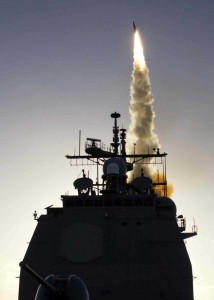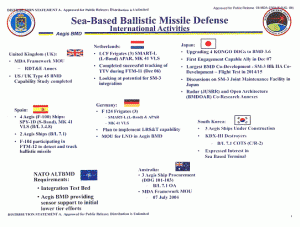
Missile defense is a global effort. It requires the global deployment of U.S. forces and the capability to connect those forces with those of its allies. Joint and coalition concepts of operations are being shaped to ensure decision makers with the options of providing defense for allied deployed forces and the homelands of the U.S. and allies. As a global enterprise, missile defense will always be a work in progress ensuring that evolutions in sensor technologies are joined with defensive missiles in a joint and combined command and control system.
The U.S. Navy’s Aegis program is an important contributor to shaping the foundation for such a global system. Through initially foreign military sales programs in Japan and eventually cooperative commercial defense programs, Aegis has become part of the allied fleet. Today five allied navies have purchased or deployed the Aegis combat system: Japan, Spain, Norway, the Republic of Korea and Australia.
An additional collaborative aspect of the Aegis program has been the central role of Spain and its industry in introducing a frigate-sized Aegis ship to the world’s fleets. The Spanish frigate series, in turn, has shaped Norwegian and Australian options. Aegis has truly become a global enterprise.
While not all of these ships are tested to be BMD capable, the sensors on the Aegis system of all of these navies can play a role in a global sensor grid important to shaping missile defense capabilities worldwide. And when one adds the consideration that the coming deployment of the F-35 Joint Strike Fighter to the U.S. fleet and to U.S. and allied air forces will add significant sensor capabilities to the U.S. Navy as well as to allied forces (all of the current Aegis navies are potential candidates for the F-35). There is a significant 21st century opportunity to shape an integrated air-sea sensor net for the deployed fleets which provides, in turn, a growing capability to shape missile defense forces and protective cover for global presence forces.
Not surprisingly, the first acquirer of Aegis, the Japanese, have taken the lead in shaping missile defense capabilities for their fleet. The Japanese are outfitting four Japanese destroyers with the Aegis BMD weapon system. The Kongo was the first Japanese destroyer to intercept successfully a ballistic missile with its Aegis BMD Weapon System in a December 2007 test. The Japanese are working closely with the U.S. Navy and the U.S. Air Force in enhancing their capabilities for missile tracking and, with the introduction of the Aegis BMD system, are deploying capabilities to turn missile tracking into an ability to defeat incoming missiles.
Two of the other Aegis navies have agreements in place, which will enhance their ability to provide for missile defense. The Spanish frigate Mendez Nunez (F-104) participated in Flight Test Standard Missile-12 by providing tracking data which involved a successful intercept. This flight mission was the third intercept involving a separating target and the first time an Aegis BMD equipped destroyer was used to launch the interceptor missile. The USS Decatur (DDG 73), using the operationally certified Aegis Ballistic Missile Defense Weapon System (BMD 3.6) and the Standard Missile–3 (SM-3) Block IA missile successfully intercepted the target during its midcourse phase of flight.

Australia signed a MDA framework MOU on July 7, 2004, which enables a working relationship to shape a role for the new Australian aegis fleet. As the Australian MOD noted about the MOU: “The Memorandum of Understanding will enable Defence to gain access to, review, and evaluate the various layered defensive systems in the US missile defence program, and decide which are appropriate areas of participation for Australia. Areas of potential interest for Australia include: Expanding our long-standing cooperation in ballistic missile early warning; science and technology. Research, development, testing and evaluation of missile defence systems; cooperation in areas such as ship- and ground-based sensors and handling data from sensors; and opportunities for Australian industry.”
“Our new Air Warfare Destroyers will be equipped with radars capable not only of detecting aircraft and anti-ship missiles, but also ballistic missiles. This information could comprise part of the missile defence network to provide early warning of an impending attack.”
The South Koreans are building three Aegis ships and the new KDX-III destroyers will able to contribute to allied monitoring capability against missile threats in Asia. The South Korean government has expressed a clear interest in se-based terminal defenses built around the Aegis system.
Other allied navies have developed and deployed advanced defense systems for their frigates as well. And several of these allies are working with the U.S. to shape a collaborative network to share data for missile warning and as capabilities are built to shape a data grid for missile warning, the potential is then created for shaping a defensive system using such data. The British Royal Navy is working with the US Navy to shape a collaborative framework for operations between the US fleet and the new UK Type 45 destroyers to enable the Type 45 to participate in joint missile defense. The British PAMS system and the Sampson radar are the systems being uses to work interoperability with Aegis.
The Dutch have engaged in a program to upgrade their frigates to enhance missile- tracking capabilities. And they participated in FTM-11 by providing target tracking along with the USS Hopper for the USS Lake Erie’s interceptor test. The Dutch use the APAR system as the basis for missile tracking, and seek to have the APAR become interoperable with Aegis.
The Germans also use the APAR system. And as interoperability of the APAR with Aegis is enhanced, the German navy will be able to share missile-tracking data more effectively with other allies.
In short, the Aegis system will play a central role both for the United States and its Aegis partners in shaping a global missile defense capability at sea. Other allies who have developed and deployed other air defense and combat systems are working with the United States to find ways to enhance the interoperability between Aegis and other allied systems. And with President Obama’s cancellation of a land-based missile defense system in Europe and a shift on emphasis to the enhanced role of missile defense at sea, the role of the Aegis global enterprise is heightened in U.S. policy.
The goal is to craft a fast response data system, which allows allies to jointly track missiles. And based on such a data system forge command and control links which facilitate joint and coalition missile defense capabilities. Given the flexibility of a sea-based force, this can permit the U.S. and its allies to deploy capabilities to dynamic threat areas in tomorrow’s world, rather than building against today’s threats alone.
As the recent assessment of the Joint Forces Command underscored, “the battle for access” in the global commons will become increasingly difficult as adversaries acquire advanced missiles and other area denial weapons. “There is also a rising danger with the increase and longer range missiles that presence forces could be the first target of an enemy’s action in their exposed positions.” It is very likely that deployed sea-based defenses will be an important element in allowing U.S. and allied “presence forces” to operate effectively.
In other words, the Aegis global enterprise lays a foundation for a global capability in sea-based missile defense. And this capability, in turn, becomes increasingly central to the freedom of action necessary for the global operation of U.S. forces and its coalition partners.
———-
***Posted September 18th, 2009

